The breakfasts we loved as kids and the Aussie cereal creations still going strong
THEY were all “part of a nutritious breakfast” once, including some classic Aussie creations. Here’s some of our favourite brekky cereals still going strong and those that are now just a childhood memory.

VIC News
Don't miss out on the headlines from VIC News. Followed categories will be added to My News.
FOR generations, Australian families have woken to a heaping bowl of cereal every morning.
Over the decades, our cereal tastes have ranged from healthy, to highly efficient sugar delivery systems, and everything in between.
Here’s a snapshot of our $1.2 billion-a-year breakfast cereal industry, the origins of our favourite brekky bowlfuls (including some Australian inventions) and the old brands we’ve left behind.
HOW OUR FAVOURITE FOODS WERE BORN
Kangaroo brains, parrot pie and roast wombat: the food of Melbourne’s early settlers
PORRIDGE
Before the production of pre-packaged cereals, many Aussie households started the day with porridge.
Plant-based porridges including semolina and tapioca were used, but the most popular porridge was prepared with oats.
Made with milk, water or a combination of the two, all kinds of things were added to this traditional breakfast such as sugar, honey, golden syrup, salt, a knob of butter or some slices of banana to make the otherwise bland bowl of oats pop.
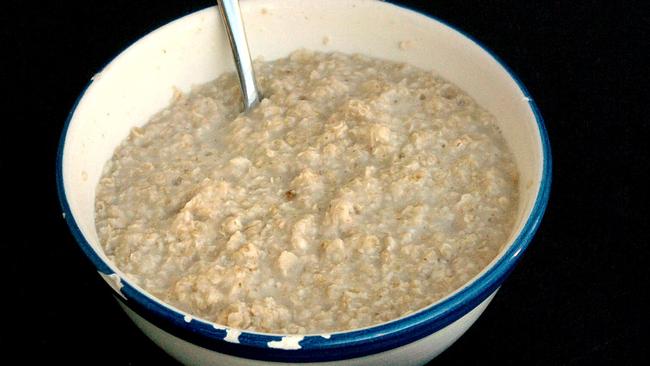
The origins of cereal manufacturer Uncle Tobys can be traced to 1861, when English immigrants Leonard and George Parsons settled in Melbourne began producing John Bull Oats as Parsons Brothers.
Meanwhile, the Uncle Tobys brand emerged in Sydney in 1893 when Clifford Love began supplying Uncle Tobys oats, later swallowing the Parsons’ business.
Today, other grain processors like Lowan and Carman’s are also competing for a spoonful of the oats market.
Along with natural oats, there is a vast range of products for modern people and families on the go. Quick oats — more finely processed than standard rolled oats for fast cooking — come in array of flavours with honey, fruits, nuts, cinnamon or vanilla and are microwavable. Just add water.
AUSSIE CLASSICS: WEET-BIX, WEETIES, NUTRI GRAIN
Some of Australia’s most popular cereals have been with us for decades, even in a dynamic and increasingly health conscious market.
Weet-Bix is an Aussie creation. It was first developed by Sydney company Grain Products Limited. They were on a winner with the little whole wheat biscuit, because Sanitarium bought out the firm in 1928. Weet Bix became a national icon as a breakfast food for World War II service personnel, high profile sporting sponsorships and its collection of kids’ swap cards.
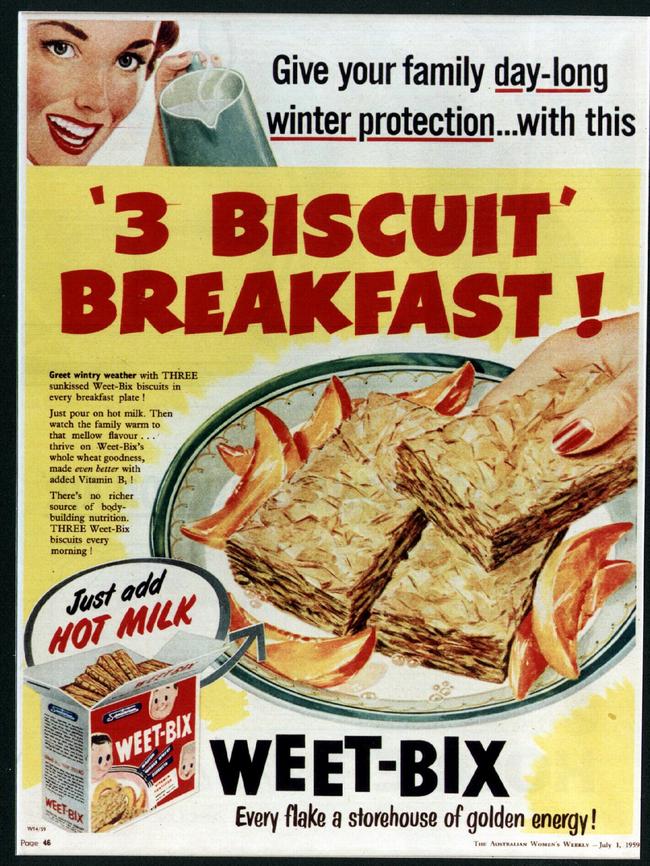
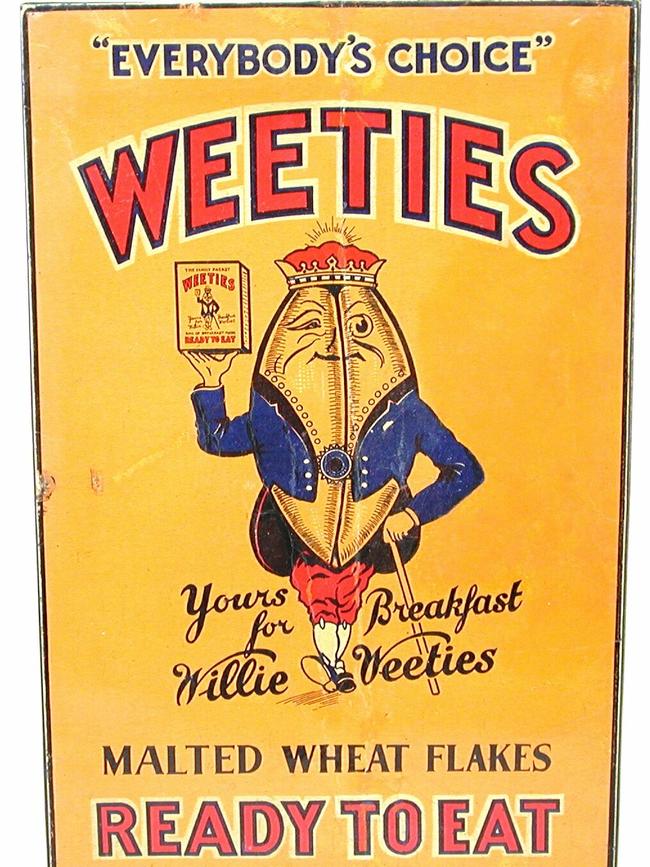
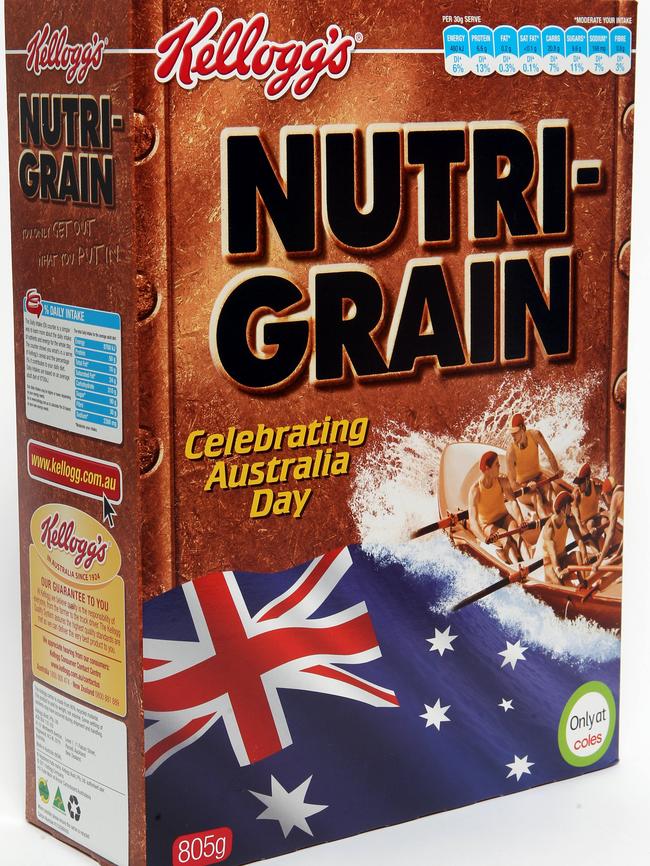
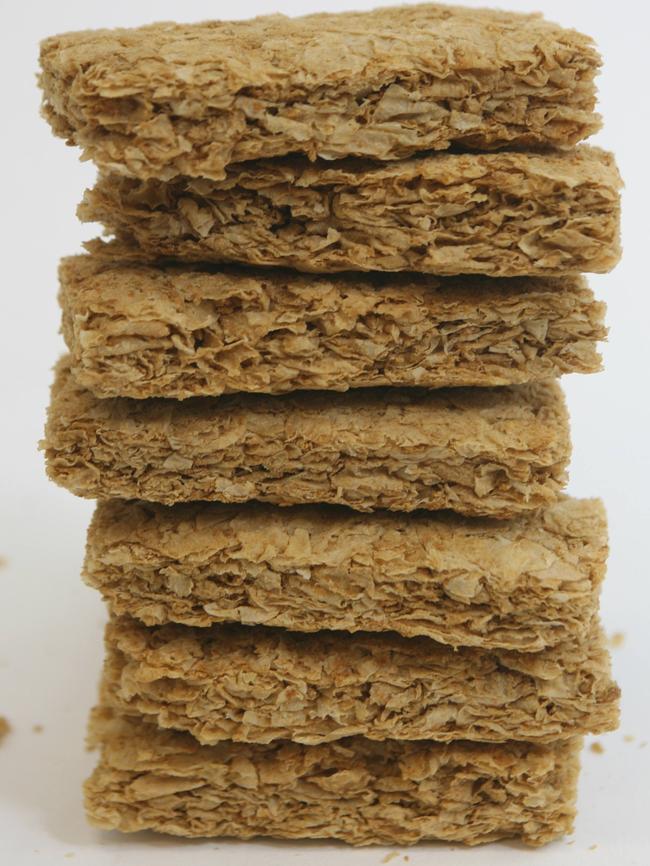
Weeties were created in Melbourne when bootmaker William Spry, in business with his brother and father in a Clifton Hill boot factory, invested in his factory neighbour Bob Creaser’s fledgling cereal business. Creaser had been to the United States and had seen Kellogg’s producing Corn Flakes and planned the same trick with wheat. Soon, Spry ploughed all his money into cereals, left the boot trade, established Spry’s and Weeties was born. King Willy Weetie is still the cereal’s mascot under Uncle Tobys ownership.
Spry’s also produced Vita Brits in the 1920s.
Shredded Wheats, another Uncle Toby’s product, are large, flat and stringy wheat biscuits. Over the years, similar products came in smaller sizes, some enclosing a fruity jelly filling.
Nutri Grain was an Australian invention of Kellogg’s, best known as “iron man food” for its association with Grant Kenny and other iron man competitors. Before that, the little holey bricks of corn, oats and wheat were linked to cricket, with campaigns headed by cricket legend Tony Greig.
Sultana Bran, a local variation on US Kellogg’s Raisin Bran, has been a breakfast staple since the mid-1960s in Australia.
KELLOGG’S
Corn Flakes were created by the Kellogg brothers in the 1890s.
The first Kellogg’s factory in Australia opened in Sydney in 1924. By 1928, the company expanded to new premises.
Rice Bubbles, a derivative of US Kellogg’s Rice Krispies, go back almost to the beginning of Kellogg’s in Australia, although it took decades for the familiar “snap, crackle and pop” slogan to be linked to the munchkin characters on the front of the box.
How do you improve Rice Bubbles? Add sugar and cocoa and turn them into Coco Pops, for generations a favourite with kids. Coco Pops also got their own mascot, Coco the Monkey, and a slogan — “just like a chocolate milkshake, only crunchy”.
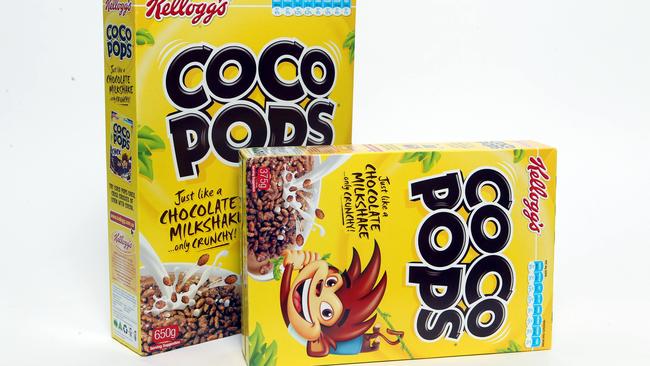
Froot Loops, another product from the American Kellogg’s stable, have captivated kids for decades — those who were allowed to eat them and those who wished they could.
The sweet, fruit-flavoured rings are famous for their mascot, Sam Toucan.
Kellogg’s Special K’s malty rice and wheat flakes have been around for decades and have been a favourite with dieters because of their low fat content.
Kellogg’s Variety Packs are a favourite for holidays — a compact way to take a variety of breakfast cereal wherever you’re travelling. The Variety Packs contained eight little boxes of popular Kellogg’s cereals, while the Fun Packs contained six. Variety Pack-sized boxes are often seen in hotel breakfast bars.
Crunchy Nut Cornflakes are a relative newcomer, arriving in the 1980s, but the sweet, nutty treat has developed a strong following. See also Frosties, which has been around in Australia for more than 50 years.
CEREALS WE’VE LOST
Puffed Wheat was produced by Sanitarium and Kellogg’s but the popcorn-like cereal, made with grains of wheat popped like corn kernels, has fallen out of favour.
The same fate has befallen Honey Smacks, the Kellogg’s sugar-laden puffed wheat derivative with Dig’Em Frog on the pack. Honey Smacks started out as Sugar Smacks in the US in 1953, but by 1976 Kellogg’s saw the beginning of a trend away from sugar and renamed them Honey Smacks in 1976, years ahead of its parent company. Aldi still sells a similar product, Honey Wheats.
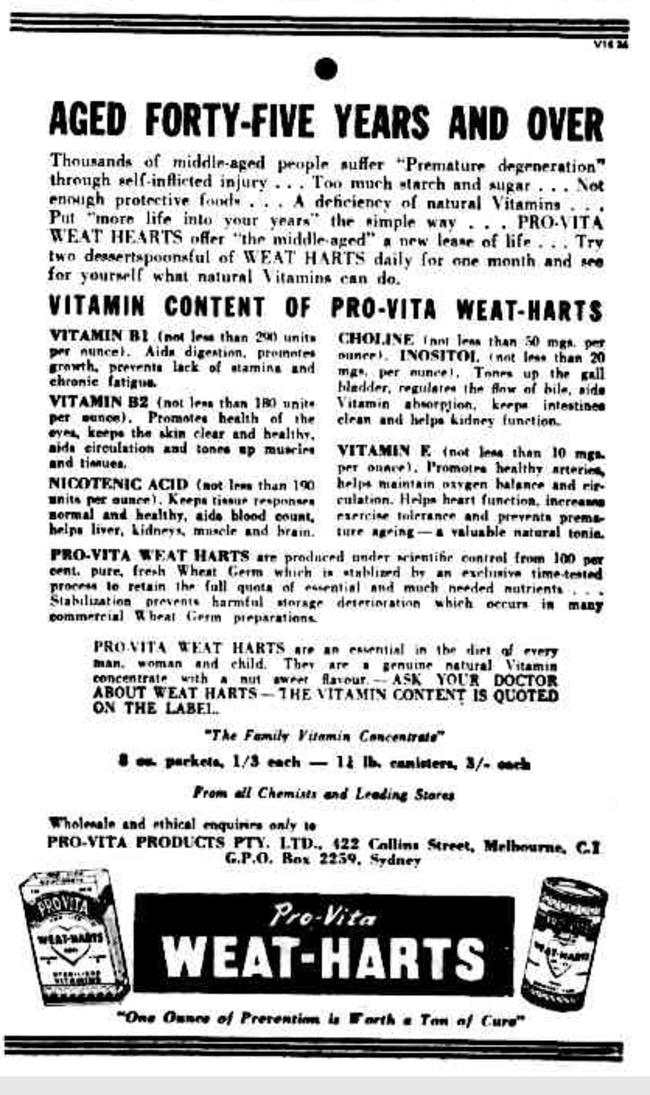
Strawberry Pops are just like Coco Pops, only strawberry. These were around in the 1970s and featured a pink elephant on the pack with the familiar milkshake slogan.
Fibre Plus was part of the Nabisco/Uncle Tobys range. The blend of grain flakes, dried fruit and nuts was marketed with health-conscious Aussies of the 1980s in mind but has long since disappeared from supermarket shelves.
Kellogg’s went in a different direction in 1989 — oat bran and health transplant pioneer Dr Christiaan Barnard — to extol the virtues of its Balance cereal. It flatlined by the end of the 1990s.
Granose was the father of Weet Bix and Vita Brits. Granose was a wheat biscuit developed by Kellogg’s. While considered quite healthy, the story goes that Granose lacked in the taste department. Weet Bix and Vita Brits were developed as a more palatable alternative and their market power gradually led to the demise of Granose.
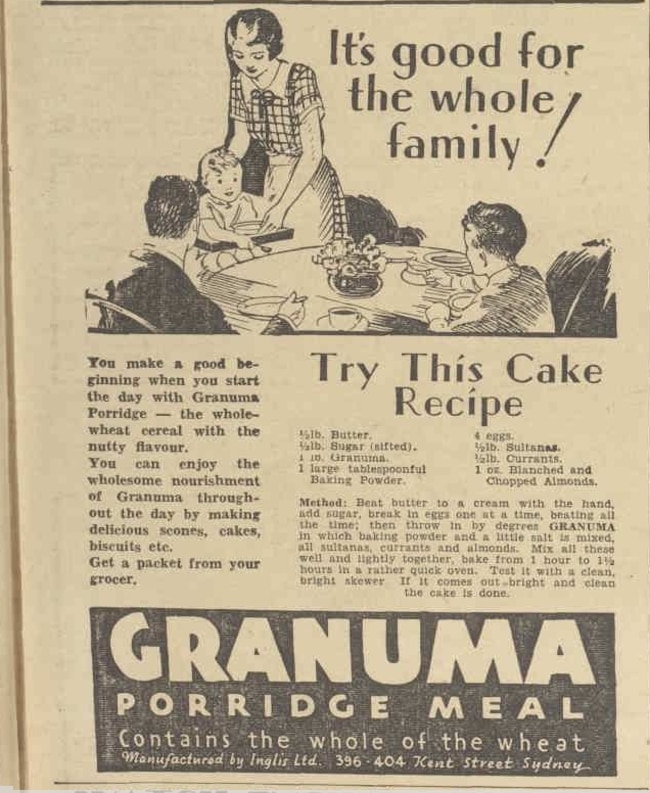
Rice Chex and Corn Chex have disappeared, but Kellogg’s still sells Crispix, a similar lattice cereal, and Coco Pops Cookies and Cream Chex.
Skippy Corn Flakes was a Sanitarium staple for years with its brightly coloured kangaroo and “Jumping with oven-fresh flavour!” slogan on the pack. The cereal did well through its association with the legendary Skippy TV series. It hasn’t been available in Australia for around a decade but, oddly, it’s still made in New Zealand.
Pro Vita Weat Harts and Cerevite Porridge go back at least six decades and were part of the Melbourne-based Allied Mills. Unlike standard porridge, Cerevite was a blend of wheat semolina, wheat germ, oat bran, salt and soy protein.
It’s gone now, but there’s a Facebook group demanding its return.
Breakfast Delight was a semolina porridge mix that was widely available in grocery shops since early last century and is well remembered by older Australians. It’s been decades since it was last seen.

Quaker Oats and Quaker Creamoata were discontinued by Uncle Tobys in 2013. Quite apart from standard Quaker Oats, Creamoata was much more finely process to produce a smoother porridge.
Crispies and Kornies, like Weeties and Vita Brits, were created by Spry’s. American company Nabisco bought out Spry’s in the mid-1960s. Crispies and Kornies disappeared after Uncle Toby’s took over Nabisco’s Australian business in the 1990s.
Kellogg’s OKs were sweet oat-based rings were similar to today’s Cheerios, which came to Australia under the Nestle brand around 15 years ago and are now part of the Uncle Tobys range. They were available in Australia until around 1970.
Granuma was a fine, wheat-based porridge that was first manufactured by James Inglis and Company in 1895. It survived into the 1950s.
Nutri Grain Flakes was a short-lived derivative of Nutri Grain, introduced in 1981.
BREAKFAST CEREALS TODAY
Diversity is the name of the game in the breakfast cereal market, but not in terms of ownership.
Major cereal companies like Sanitarium, Uncle Toby’s and Kellogg’s look to leverage their strongest cereal varieties, by repackaging the product with different flavours and styles linked back to the popular original.
Weet Bix, for example, comes in many forms including a cholesterol-lowering variety, Blends (with added fruit flavours or higher fibre), Bites (fruit and honey flavoured mini-bix), Weet Bix Go box and mini-bix packaged to carry with us and a gluten-free option.
Cereals such as All Bran, Special K and Coco Pops all have many variations.
Sanitarium also has its Up&Go liquid breakfasts, and Kellogg’s has branched Nutri Grain into bars and protein drinks.
Convenience options, including individual serves of cereals or porridge, are common these days too.
Breakfast cereals marketed as healthier options have gained a significant foothold on supermarket shelves with brands including Carman’s, Be Natural, the Uncle Toby’s Plus and O&G range of cereals and mueslis.


